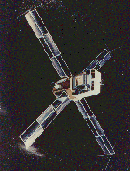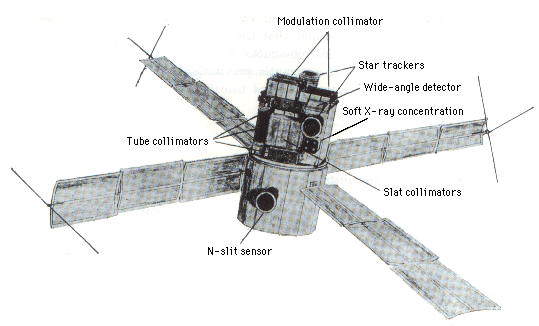|
|

SAS-3
SAS-3 was launched May 7 1975 from the Italian San Marco launch
facility located off the coast of Kenya. Its initial orbit
was equatorial. The mission was designed as a spinning satellite,
but the spin rate was controlled by a gyroscope which could be
commanded to stop rotation. In this way, all instruments could be
pointed providing about 30 minutes of continuous data on a given
source such as a pulsar, burster, or transient.
The nominal spin period was 95
minutes, which was also the satellite orbital period.
The SAS-3 scientific payload was designed and built at MIT.
SAS-3 carried four X-ray experiments: modulation collimator,
slat collimators, tube collimators and soft X-ray concentrator.
The figure shows the location of each experiment
as mounted on the SAS-3 satellite.
The Z-axis is perpendicular to the solar panels.
 Below follows a brief description of the onboard experiments:
Below follows a brief description of the onboard experiments:
- 2 rotating modulation collimator systems. These were composite of
a modulation collimator in front of a bank of proportional counters
that detect X-ray in the bands 2-6 and 6-11 keV.
The collimator has a transmission band with a FWHM of 4.5 arcmin
and an overall FOV of 12° X 12° centered on the
direction parallel to the spin axis (satellite Z-axis).
- 3 crossed slat collimators each with proportional counter.
They were designed to monitor a large portion of
the sky in a wide band of directions centered on the plane
perpendicular to the rotation axis of the satellite (+Z). Each
detector consisted of a proportional counter and collimator with
an on-axis effective area of 75 sq-cm. The collimators define 3
long, narrow fields of view which intersect on the +Y axis and are
inclined with respect to the YZ plane of the satellite at angles
of -30°, 0°, and +30°, respectively. During scanning
mode, an X-ray source would appear successively in the 3
detectors. Three lines of position could then be obtained, and
their intersection determined the true source position. The center
collimator had a field of view with FWHM 1° by 32° and a FW
of 2° by 120°. The left and right collimators had narrower,
but similar responses, i.e., 0.5° by 32° (FWHM) and 1.0°
by 100° (FW). The proportional counters were filled with argon
and were sensitive in the range 5-15 keV. In addition the center
detector had also a xenon counter, located behind the argon detector,
that extend the response to 60 keV
Over the energy range 1.5-6 keV, 1 count/s = 1.5x10-10
ergs/sq-cm/s for a Crab-like spectrum. In any given orbit, ~60% of
the sky was scanned by the center slat detector with an exposure
ranging from 300-1125 sq-cm sec.
- 3 tube collimators (which were located above, below, and to the
left of the slat collimators) that defined a 1.7 degree circular
FOV. The tube collimator located above the slat collimator was
inclined at an angle of 5 degrees above the Y-axis, and could
therefore be used as a background reference for the other tube
collimators that view along the Y-axis.
- 1 low-energy detector system to the right of the slat
collimators. It consisted of a set of 4 grazing incidence,
parabolic reflection concentrators with 2 independent gas-flow
counters sensitive to X-rays in the range 0.15-1.0 keV.
The main scientific hightlights of the SAS-3 mission
included: the discovery of a dozen X-ray burst sources
(including the Rapid Burster);
the discovery of X-ray emission from HZ 43 (isolated white dwarf),
Algol and from AM Her (the
first highly magnetic white dwarf binary
system seen in X-ray) precise location of about 60 X-ray sources.
This latter effort
established many new Be-star binaries as a class of X-ray emitters,
brought about the first identification of bursting sources with
X-ray binary systems, identified the first quasar located
through its X-ray emission, and demonstrated the central
location of X-ray sources in globular clusters.
[SAS-3 Home]
[About SAS-3]
[Archive]
[Gallery]
[Publications]
Page authors: Lorella Angelini Jesse Allen
HEASARC Home |
Observatories |
Archive |
Calibration |
Software |
Tools |
Students/Teachers/Public
Last modified: Wednesday, 08-Oct-2003 19:02:43 EDT
|



 Below follows a brief description of the onboard experiments:
Below follows a brief description of the onboard experiments: